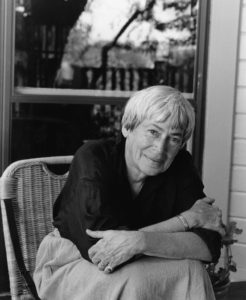Marleen S. Barr remembers a titan of science fiction deeply inspired by anthropology
11 May 2018 (Sliema, Malta) – I met the science fiction author Marleen S. Barr at a book event in NYC last year. She had a short-fiction collection called “When Trump Changed” and she talked about how Trump has inspired her work, and why science fiction might be the next big feminist frontier. She teaches English at the City University of New York. And while most English professors have normal fields such as Shakespeare, Medieval Literature, or Modern Drama, she is the first female English professor to call Science Fiction her area of expertise. She has won the Science Fiction Research Association’s Pilgrim Award for lifetime achievement in science fiction criticism.
She has noted that at the start of her career “science fiction was viewed as crap; feminist science fiction was viewed as being beyond the pale of crap”. But she knew it would improve. And she was proven to be spot on right. Ursula K. Le Guin and Octavia E. Butler are venerated. “The Handmaid’s Tale” speaks to contemporary feminist issues.
The following is Marleen’s tribute to Le Guin and was published in Nature magazine in March of this year:
I was watching the news this January when an image of Ursula K. Le Guin flashed up on the screen. For a second, I hoped that I was about to see a celebration of her latest achievement. When the anchor announced her death, my response was visceral.
Le Guin was a colossus of literature, and of anthropological and feminist science fiction in particular. In addition to her 22 novels, she published 11 short-story collections, 5 works of criticism, 13 books for children and several volumes of poetry. Her range was enormous, from the fantasy classic A Wizard of Earthsea (1968) to the great explorations of genetic engineering, gender, war and environmental despoliation in works such as The Dispossessed (1974). Among her many awards was the US National Book Foundation’s Medal for Distinguished Contribution to American Letters, presented in 2014.
These achievements sprang from the early challenges Le Guin faced. Her first five novels, written between 1951 and 1961, were rejected by publishers who deemed them inaccessible. Happily, Le Guin remained true to her voice. She focused on clashes between worlds, and how race, gender, ethnicity, sexuality and class inform those clashes. She launched anthropology into outer space. Her extraterrestrials signify that marginalized groups are not inferior; their viewpoints are ‘other’ only in relation to white patriarchal hegemony.
To understand Le Guin’s preoccupation with otherness, it is key to recognize that she, like many of science fiction’s great literary lionesses, experienced separation from Western society in her childhood. Doris Lessing grew up in what is now Zimbabwe; James Tiptree Jr (the pen name of Alice Sheldon) travelled with her family in central Africa; Margaret Atwood spent much of her childhood in the backwoods of northern Quebec, Canada, with her entomologist father. Le Guin’s separateness arose from periodic childhood immersion in the semi-wilds of California, and from her anthropologist parents.
Le Guin was born in 1929 to Alfred Kroeber, who worked with the Native Americans of California, and fellow anthropologist Theodora Kroeber. Theodora’s acclaimed 1961 study Ishi In Two Worlds had a huge influence on her daughter. It was derived largely from the work Alfred had done (aspects of which were controversial) in the 1910s with Ishi, whose people, the Yahi, had been wiped out by genocide. The Kroeber family spent summers at the Kishamish ranch in the idyllic Napa Valley, in an intellectual milieu embracing Native American and European friends. Physicist J. Robert Oppenheimer was also a visitor.
I believe that much of Le Guin’s astounding ability to think outside the Western cultural patriarchal box derives from her early exposure to Ishi’s story. That history informs the interplanetary cultural constructs in Le Guin’s great works of the 1960s and 1970s: Planet of Exile, City of Illusions, The Word for World Is Forest and The Dispossessed. And in the 1969 The Left Hand of Darkness, anthropologist-emissary Genly Ai experiences an alternative to gender difference so convincing that his observation “The King was pregnant” does not seem dissonant.
Ishi, as the last of his people, might have inspired Le Guin to write her 1973 short story ‘The Ones Who Walk Away from Omelas’, which describes a utopia pivoting on the misery of a single abused child. The Native Americans she knew in her youth, who revered nature and did not embrace Western technology, could also have inspired the “churten principle”, or “transilience” — spaceflight facilitated by storytelling — in Le Guin’s 1990 short work, ‘The Shobies’ Story’.
Le Guin was loved by the science-fiction community because, to use the parlance of the moment, she rescued the genre from being viewed as a “shithole country”. When she asked questions such as “Why are Americans afraid of dragons?” (in the eponymous essay of 1974), hers was the loudest roar emanating from science fiction’s pride of literary lions. This is why, in 1994, I called Le Guin the Virginia Woolf of our time.
Le Guin, like Woolf, was a principled feminist with a unique, transcendent voice, in pursuit of the substrate of truth. In that 1974 essay, she defended “the uses of the imagination … most especially in fairy tale, legend, fantasy, science fiction, and the rest of the lunatic fringe” thus:
“I believe that all the best faculties of a mature human being exist in the child, and that if these faculties are encouraged in youth they will act well and wisely in the adult, but if they are repressed and denied in the child they will stunt and cripple the adult personality. And finally, I believe that one of the most deeply human, and humane, of these faculties is the power of imagination.”
